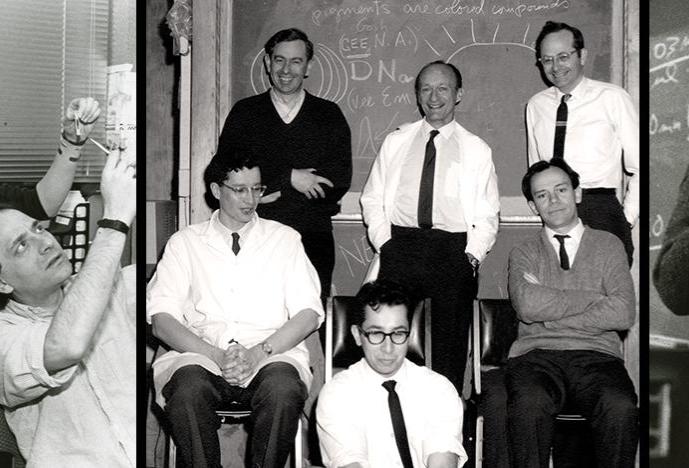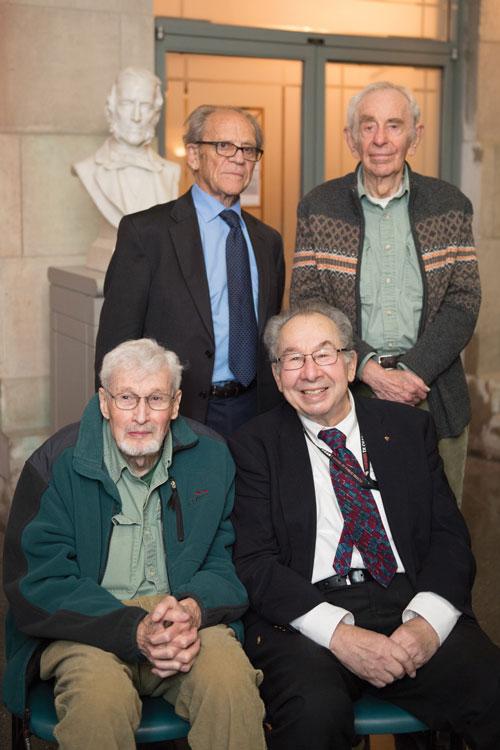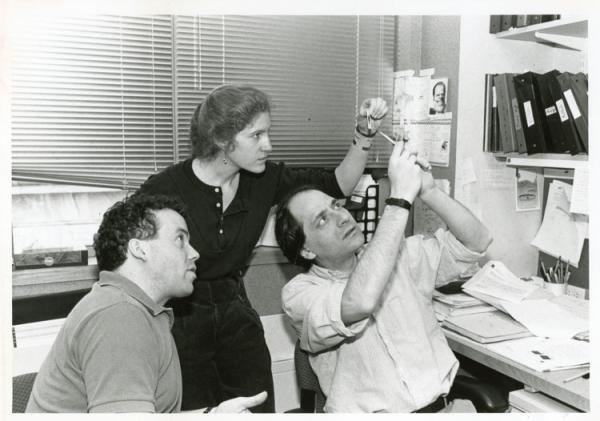On Our Mind
The multidisciplinary study of the brain got its start at HMS more than fifty years ago
- Feature

The six founders of neurobiology at HMS (center image: clockwise from left, standing): Edwin Furshpan, Stephen Kuffler, David Hubel, Torsten Wiesel, Edward Kravitz, and David Potter
Today, most science watchers know that the stereotype of the solitary scientist chipping at one sliver of a question after another is myth. Time and again, we learn of breakthroughs that result from the coordinated work of a research team—individuals from various disciplines contributing their expertise to the resolution of shared questions.
When discoveries are achieved, scientists celebrate, perhaps with a toast to the publication of a particularly insightful paper or simply with a get-together to acknowledge the work of the team.

When, however, a discipline has the opportunity to mark not only decades of discoveries but also a revolutionary approach to how research in that discipline is undertaken, its practitioners turn to ceremony to reflect, reminisce, and recommit to their life’s work.
So it is in 2016 at HMS, where the Department of Neurobiology, the nation’s first academic entity conceived of and built upon the multidisciplinary study of the brain, is marking a half-century of collaboration and discovery.
Hemispheric Changes
Any story that goes back fifty years inevitably starts even further back, and often includes an element of serendipity. For HMS neurobiology, that element can be traced to Australia and tennis.
In the late 1930s, the two came together in a life-changing way for Stephen Kuffler, a native of Hungary who had earned his medical degree at the University of Vienna. Kuffler’s memoir was included in an article written by Bernard Katz, a biophysicist who shared the 1970 Nobel Prize in Physiology or Medicine for his work on nerve biochemistry, and published in 1982 in the Biographical Memoirs of Fellows of the Royal Society. According to that memoir, Kuffler emigrated to England after the Nazi invasion of Austria, then opted to relocate to Australia, perhaps in the hope of being able to practice medicine again. Shortly after beginning a job at the University of Sydney, he was introduced to a researcher at the university, one who happened to be looking for a tennis partner. That researcher was John Eccles, a neurophysicist who would share the 1963 Nobel Prize in Physiology or Medicine for his work on synapses.
Game, Set, Match
Theirs proved to be a good tennis pairing. That successful collaboration led to another when Kuffler joined Eccles’s lab. In 1939, Katz, too, joined the lab. Being mentored by Eccles and Katz, two established leaders in the study of neuronal physiology, proved significant for Kuffler for it helped him realize that brain research required the perspectives of different disciplines. That realization set the stage for his new vision for research in a field he called neurobiology.
In 1941, Kuffler achieved international notice for achieving the first isolation of a single muscle fiber together with its neuronal connection. He was invited to join the physiology faculty at the University of Chicago in 1944, and, in 1947, began a twelve-year stint at what was then the Johns Hopkins University Medical School. There, according to the article by Katz, Kuffler worked on the mammalian retina and stretch receptor neurons in crustaceans. He also built a cohort of colleagues who, in 1959, moved with him to HMS. That cohort included researchers who would become the core of the School’s nascent neurobiology department, a group Kuffler referred to as “the boys”: Edwin Furshpan, David Hubel, David Potter, and Torsten Wiesel.
A Vision Realized
With the addition of Edward Kravitz in 1960, the team’s membership totaled six, all working in a neurophysiology laboratory housed within the HMS Department of Pharmacology. But Kuffler was already building support among the HMS faculty for a new department. When Otto Krayer, the chair of pharmacology, announced his retirement in 1965, Kuffler was ready to act.
According to Kravitz, now the George Packer Berry Professor of Neurobiology at HMS, “Dean Robert Ebert came to Steve and said, ‘Would you like to be the chair of physiology or pharmacology?’ Steve said he didn’t want either, that he wanted to start an entirely new department, one that brought expertise from several disciplines to the study of the brain.”
In 1966, the HMS Department of Neurobiology was launched; a chart of the new department may well have looked like a crowded Venn diagram, its overlapping circles representing physiology, biochemistry, neuroanatomy, and electrophysiology.
Good Chemistry
Even before the department’s name was painted on the door, its members had made some significant contributions to the field. Says Kravitz, “We had produced some important results, including staking out our position on a heated international debate over the fundamental nature of neural transmitters.”

That position evolved from work published in Nature in 1962 by Potter, Kravitz, and others, in which they showed in lobsters that an amino acid called gamma-aminobutyric acid (GABA) was produced by the neurons and could inhibit or slow neuronal activity. Until that time, neurotransmitters, substances that regulate the movement of signals from one brain cell to another, were thought to be electrical entities only. GABA, by comparison, was a chemical. The Nature paper provided the first definitive proof that GABA was an inhibitory chemical made by neurons and laid the foundation for work on GABA in the mammalian brain.
The lab’s stature was further enhanced one year later when Hubel and Wiesel published their work on the visual cortex. In describing columns of cells that receive, refine, and pass along images from the retina, they demonstrated how those images come into focus in the brain and introduced the concept that experience can shape the brain’s circuitry during what they described as “critical periods” in early life. This work offered one of the earliest indications that the brain is shaped by experience as well as genetics—a concept fundamental to brain plasticity. This research by Hubel and Wiesel earned them the 1981 Nobel Prize in Physiology or Medicine and further bolstered the department’s reputation for innovation and discovery. Before his death in 2013, Hubel was the John Enders University Professor and an emeritus professor of neurobiology at HMS; Wiesel is the Vincent and Brooke Astor Professor Emeritus at The Rockefeller University.
Transitions
Kuffler had cultivated a forward-thinking culture among the department’s researchers and that philosophy remained in place when he died in 1980. Wiesel became the new chair, followed in 1982 by Potter, now the Robert Winthrop Professor of Neurobiology Emeritus. During their respective terms leading the department, each continued to recruit faculty who brought diverse expertise to the group. Many of those selected were visionary and enterprising in their own ways. Several would later start up programs in neurobiology at other universities.

Two examples of this legacy are neurobiologists Zach Hall, who created an interdepartmental neurobiology program at the University of California, San Francisco, and Story Landis, who was the director of the Center on Neurosciences at Case Western Reserve University School of Medicine. Hall and Landis later each served as director of the National Institute of Neurological Disorders and Stroke.
Making Sense of the Senses
The early work by Eccles and Katz, as well as the work now underway in the department, has contributed to our understanding of the pathways of sensory information to the brain and have led to a greater understanding of the mechanisms of neural activity.
With each decade, department faculty expand our understanding of how sensory information—the stimuli our eyes, ears, skin, and other sensory organs receive from the world we live in—is interpreted by our brains and shapes our behavior. Examples of some of the areas in which researchers in the department made contributions include the discovery of the mechanism by which the nervous system changes to respond to chronic pain; description of the functionally distinct regions for the processing of form, color, motion, and depth in the visual systems of primates; development of molecular and biophysical analyses of auditory hair cells; and explanations for how odor receptors are organized in the nose, how they organize into the olfactory bulb, and how the information gathered by the olfactory neurons is processed in the brain’s cortex. The olfaction work, some of which was undertaken by Linda Buck during her tenure at HMS, later earned her and another researcher in the field the Nobel Prize in Physiology or Medicine.
Buck had been recruited to the department by Gerald Fischbach, who became chair in 1990. Although Fischbach, currently vice president for health and biomedical sciences at Columbia University and chief scientist and fellow at the Simons Foundation, had not been a part of Kuffler’s original group, he took its traditions to heart by hiring and retaining faculty who brought their own diverse fields of expertise. So, too, did Carla Shatz when she took the helm of the department in 2000.
Shatz, now a professor of neurobiology and biology at Stanford University and director of Bio-X, Stanford’s interdisciplinary institute, represented two firsts for the department: She was the first graduate of the HMS department (PhD 1976) to become its chair and the first woman to lead it. Her connections to the department went even deeper. While a student at Harvard College, Shatz worked on her honors thesis in chemistry in the lab of Hubel and Wiesel. Later, Shatz carried out her PhD work with Hubel and Wiesel.
The Long View
When Michael Greenberg, the Nathan March Pusey Professor of Neurobiology at HMS, was appointed chair of neurobiology in 2008, he, too, felt at home in the interdisciplinary tradition that had been fostered since Kuffler’s founding of the department. Greenberg, however, has his own vision of how that tradition would be expressed in the twenty-first century.
“We need to bring people together, as Kuffler did, but on a grander scale,” says Greenberg. “We need expertise in physics, chemistry, and biology as well as in divisions within each discipline, and we need mathematics, engineering, molecular biology, and genetics. We need a lot of fields to come together.”

After years of discovery related to the brain’s mechanisms—neurons, synapses, and transmitters—the research of recent decades has begun to investigate connections: how groups of neurons communicate, how extensive and interconnected the network of brain cells is, and what interplay exists among the molecular mechanisms that shape or control neuronal function and sensory input.
Neurobiology faculty, for example, are applying engineering fundamentals to investigations of how decisions are made, and they are using computational tools to theorize how networks of neurons translate sensory information and use it to make behavioral decisions. Others are combining genetic tools and electrophysiological techniques to tease out how sensory stimuli, particularly sound and smell, are processed; devising better tools for imaging neurons, including the minute extensions called dendrites that communicate signals; and using circuit mapping, molecular genetics, and behavioral analysis to elucidate the intricacies of touch.
When Greenberg thinks about the early days of the department, he acknowledges, “it was a fantastic time to be a neuroscientist because many fundamental, exciting, transformative discoveries were being made.
“But this is a field where there’s still much more to be discovered that’s equally exciting. The collaborations among researchers in this department will not only continue to provide important insights into brain development and function but will also provide the key to understanding neurological and psychiatric disease.
“It’s a great time to be a neuroscientist.”
A video of department faculty produced for the anniversary celebration can be viewed here.
Michael Rafferty is a Massachusetts-based science writer.
Images: Francis A. Countway Library of Medicine; Gretchen Ertl Photography